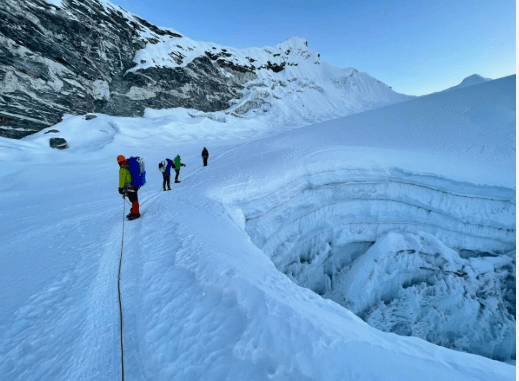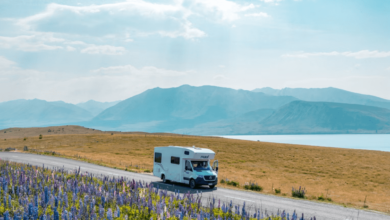
Island Peak Climbing and Everest Base Camp: Top Tips for Success on This Iconic Route
Everest Base Camp and Island Peak Climbing trek is the ultimate goal of all trekker-adventurers for most climbers. Lying in the center of Nepal’s Khumbu, these legendary trails give the finest mix of trekking and technical climbing.
EBC gives the rush of the planet’s highest place, and Island Peak at an elevation of 6,189 meters gives the spine-tingling climb. Together, they represent one of the most coveted challenges in high-altitude trekking and mountaineering on the planet.
The draw of this adventure is not only in its stunning scenery—stretching from Everest’s imposing presence to the snow-dusted plateaus of the Himalayas—but in the sense of achievement it yields. Reaching the summit of Island Peak after completing the EBC trek is a rewarding experience that requires physical endurance and mental resilience.
Combining the two experiences provides the trekkers with the chance to push their limits, test their abilities, and experience the thrill of climbing one of the world’s most legendary trails. This article shall provide the climbers and trekkers with practical tips to prepare for victory on this challenging yet worthwhile journey.
The Route Overview
The Everest Base Camp Trek is one of the globe’s most popular treks, allowing climbers to tread in the footsteps of climbers as they climb towards the summit of Mount Everest. The trek begins in Lukla, where climbers fly into the Solu-Khumbu district, and continues on a well-established path through Sherpa villages, forests, and mountain terrain.
The principal stopping places are Namche Bazaar, the chaotic gateway to the Himalayas, Tengboche, and its famous monastery with an Everest view, and Dingboche, a main acclimatization point. Trekkers will press onward to Gorak Shep from here as they head to Everest Base Camp, where the astounding vistas of close-by peaks and glaciers leave an individual with an air of fulfillment.
Island Peak, or Imja Tse, is a 6,189-meter peak located in the Khumbu region. Although technically a “trekking peak,” it is utilized as a training climb for those with Everest in mind, as it requires mountaineering techniques like the use of crampons, ice axes, and ropes.
Climbing is physically challenging but gives a taste of high-altitude climbing in a safe and controlled environment.
Almost all trekking itineraries combine the Everest Base Camp Trek with the Island Peak Climbing for an experience that is better experience. A typical program spans 16-20 days to allow for acclimatization and preparation for climbing.
After the trek to Everest Base Camp, the climbers head to Island Peak Base Camp and embark on the final ascent to the summit. This blend allows mountaineers to have access to the whole spectrum of high-altitude climbing and mountaineering within the Everest region.

Preparation for the Trek
Physical Conditioning
To join Island peak climbing via EBC trip, one must have a good level of physical fitness. The trek itself is strenuous, with endurance and stamina required to deal with long walking days at high altitudes. Mountain climbers must undergo cardiovascular training, such as running, cycling, or swimming, to develop endurance.
Leg strength training, core strength training, and upper body strength training must also be done, as this conditions the body to climb mountains and walk with a daypack for a few hours. Acclimatization to high altitudes must also be done; high-altitude conditions can be simulated by high-altitude areas or wearing elevation masks.
The addition of endurance training that simulates uphill walking, such as stair climbing, would acclimatize the body to react to the physical stresses of climbing and trekking.

Gear and Equipment
A successful and safe trip needs proper gear. For an Everest Base Camp trip, the essentials are: trekking poles, a quality backpack, sturdy hiking boots, thermal clothing, a cold-weather sleeping bag, and waterproof gear (rain pants, jacket).
A sun hat and sunglasses are also necessary to protect the eyes from the sun. During island peak climbing preparations, crampons, an ice axe, ropes, a climbing harness, gaiters, and insulated gloves are more specialized mountaineering equipment. A high-altitude mountaineering tent and a headlamp should also be there for mountain protection.
Permits and Regulations
The climbers have to get several different permits for the trip, which are the Sagarmatha National Park Permit to climb to Everest Base Camp, the Trekking Information Management System (TIMS) card, and the Climbing Permit to climb Island Peak.
The permits are bought either from trekking agencies or from the Nepal Tourism Board. Get an early application, as island peak climbing permits typically require proof of mountain climbing experience or working for a guide.
Hiring Guides and Porters
It is advisable to employ veteran porters and guides, particularly when ascending Island Peak. Guides are their weight in gold to get you safely through the country and teach technical climbing skills, and porters can carry your gear so that you can focus on climbing. Local guides will usually have enough information about the local weather, terrain, and cultural practices to make the journey safer and more convenient.
Altitude and Acclimatization
The Importance of Acclimatization
Acclimatization is essential for anyone trekking or climbing at high altitudes, especially places like Everest Base Camp and Island Peak. When you ascend, the air’s oxygen decreases, putting your body under stress. If you fail to acclimatize, your body will not be able to handle the lower oxygen, and you will have a very high chance of getting altitude sickness, which can spoil your trip. True acclimatization allows your body to adapt slowly, increasing oxygen consumption while decreasing the chances of serious issues.
Preventive Tips to Avoid Altitude Sickness
To acclimatize safely, climbing gradually is essential. The traditional recommendation is not to ascend more than 500 meters per day when ascending above 3,000 meters. Including rest days on your itinerary is crucial to allow your body to get used to it.
Hydration also matters because dehydration will increase the effects of altitude sickness. Eating high-calorie foods may provide your body with the fuel it needs to adapt. Sleeping low and going up high is the normal scheme—going higher by day and sleeping lower allows your body to acclimatize.
Symptoms of Altitude Sickness
Headache, dizziness, nausea, fatigue, and shortness of breath are all normal symptoms of altitude illness. If any of these are experienced, it is crucial that climbing is stopped and one descends as quickly as possible to a lower altitude.
If they persist, one should get medical attention. It is possible to prevent life-threatening illnesses such as high-altitude pulmonary edema (HAPE) or high-altitude cerebral edema (HACE) by detecting these symptoms early and descending quickly.
Navigating the Terrain and Weather
Terrain Challenges
Everest Base Camp Trek is a mix of difficult trails, steep hill climbs which are steep, and boulder rocks. Going up through deep forests and hanging over bridges, the path gradually ascends, especially after Namche Bazaar. As you approach Gorak Shep and Everest Base Camp, the land becomes rocky with open winds.
Island Peak requires technical mountaineering with snowy, icy slopes and steep snowy paths to the summit. To counteract these challenges, trekkers must acclimatize to uneven ground, high-altitude climbs, and the use of trekking poles for stability, and climbers must learn crampon and ice axe techniques.
Weather Conditions
From the spring season (March to May) and autumn season (September to November), the weather in general remains consistent, but there may be extreme temperature drops, particularly at the higher elevations. Day temperatures range from 10°C to 20°C at lower levels, but fall to -10°C to -20°C in higher altitudes.
Weather tends to be unexpected with snow showers at any time or heavy wind, so ensure to carry sufficient layers of cold clothes, wind jackets, and insulated gloves in order to stay warm and protected from the cold.
Climbing Island Peak
The last climb of Island Peak from Base Camp is strenuous, with poor snow and rocky terrain. The ascent starts with a ridge walk, which is followed by an advanced rock climb that requires high skill and balance. Glaciers and snowfields with difficult and slippery sections are ahead of the climbers when ascending.
Mountaineering involves the need for special equipment such as crampons, ice axes, and ropes. Mountaineers put their hands and feet in such a position to facilitate a push upwards as they ascend the icy steep ridges. Climbing is physically demanding and mentally testing with climbers resisting blinding wind and temperatures below sub-freezing. Maintaining a steady rate demand focus on challenging areas such as the summit ridge.
Check all your gear carefully for wear and tear at all times. Keep your carabiners, harness, and ice axes in good condition. Good communication with your guide is very important during the climb. Proper rope handling and proper distance between climbers will keep everyone safe during the climb.
Mental and Emotional Preparation
Developing Mental Toughness: Mountaineering and high-altitude trekking require mental toughness. The mountaineers will experience fatigue, fear, and uncertainty. The most challenging part is resisting fatigue, especially when climbing steep inclines or in unfavorable weather conditions.
To overcome, simply remember the destination—the summit—and divide the process into infinitesimally minute steps. Thinking of success and remembering your capability can conquer fear.
Stay Positive: Positivity is the key to those high-stakes situations. If trekking is tough, reward yourself for the small triumphs along the way, e.g., altitude gain or traversing a difficult section. Maintain your companions as optimistically as possible by friends with other trekkers or soaking up optimistic motivational environments around you.
Managing Setbacks: Setbacks like weather delay, altitude, or physical fatigue are inevitable. The awareness of the inevitability of setbacks can clear your mind. Keep your focus on your end goal, take a single day at a time, and trust your training.
Conclusion
The Island peak climbing with EBCtrek is a life-changing experience that takes you to the extremes of physical and mental exhaustion. The breathtaking views, self-realization, and achievement make the experience worth nostalgic about. Provided that you plan well and are decisive, you can conquer this challenge—so plan and move a step towards your summit!




